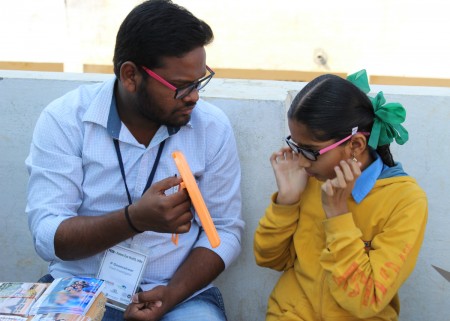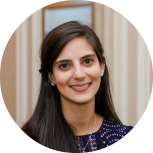
A girl receives glasses as part of a USAID-funded school eye health programme in India, using Peek technology.
Credit: Peek Vision / USAID
Imagine being six years old, sitting in a classroom and looking forward to playing with your friends during break time. Except you can’t see your friends. In fact, you struggle to see a few feet ahead of you and the blackboard is a big blur.
School eye health is important because it affects individual children – this was me. I stopped engaging in the classroom and the playground became the opposite of fun. My visual impairment went undetected for at least six months, until I tripped up over the teacher’s dog.
It would be fair to say that I got involved in school eye health when I was six years old. I may have been slightly young to make a difference then, but I knew what I wanted to do. Today, as an optometrist and global eye health researcher, it is clear to me that school eye health needs to be in every national health strategy. It should be on the agenda of not just Ministries of Health but also Education Ministries.
An estimated 12.8 million children aged 5-15 years old are visually impaired due to uncorrected or inadequately corrected refractive errors (problems with their distance or reading vision). The majority of these children would be able to see clearly with a simple pair of spectacles.
Eighty percent of what a child learns is processed through their visual system. Ensuring that children have their vision screened, are correctly identified and can access treatment if they need it is critical. Not only will it ensure that children are benefiting from the quality education that they deserve, but on a global level it will bring us closer to achieving the Sustainable Development Goals.
My work over the last decade has included research into evidence to improve the efficiency and effectiveness of school eye health programmes. This has entailed two clinical trials in India investigating the use of ready-made spectacles and using the innovative technology developed at Peek Vision to deliver health education to parents, teachers and children.
My role means we can use this information to help implementers influence the design of the programmes to ensure quality programmes that meet global standards are delivered. I am exposed to different local situations that give me an understanding of the different models of delivery of school eye health programmes.
Through this process, it became apparent that a major barrier to the delivery of quality school eye health programmes is the lack of standardisation on how these programmes should be implemented.
In collaboration with eye health experts in the field, I was part of the IAPB group that published Standard School Eye Health Guidelines for low and middle income countries that can be adapted to their location. In my role as the secretary for the IAPB School Eye Health Working Group we always welcome feedback from those that are using the guidelines.
It is important to understand that ‘one size does not fit all’ when it comes to the design and delivery of school eye health programmes. It is crucial to adapt the programme to meet the local needs and base it on what human resources and infrastructure are available in each context. We need to address service delivery, access to affordable quality spectacles and treatment, health promotion, advocacy and policy change at both national and global level.
Of course, there are key components that must be included in all programmes, but the one that sometimes gets forgotten is access to treatment. Be it a pair of spectacles or a medical intervention, if a child is screened, identified and diagnosed to require treatment, it is imperative that the programme has made adequate provisions appropriate for the local context for this.
Collaboration and inclusion of government (health and education sector), non-governmental organisations, civil society, researchers, innovators and private sector is key for the future of school eye health. A number of collaborative efforts have made strides in this such as Our Children’s Vision campaign, the Orbis REACH programme, Eyelliance etc. The challenge now is scaling up services in a standardised manner and ensuring that all the stakeholders are part of this process – working together, we can transform the eye health of a generation.

About the author: Priya has over 12 years of experience in the field of public health. She is a trained optometrist who is now at the forefront of public health optometry. She practiced community and hospital optometry for several years, before joining the International Centre for Eye Health (ICEH) at London School of Hygiene & Tropical Medicine (LSHTM) to pursue her interest in public health full-time. She is a research fellow at the LSHTM, has worked on eye health research in multiple countries (Africa and Asia), and has a PhD in child eye health with a focus on school eye health services.